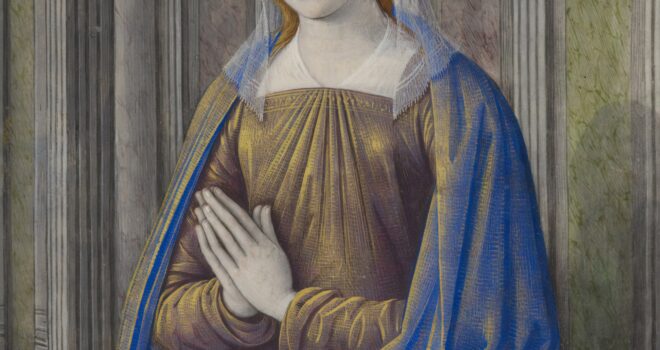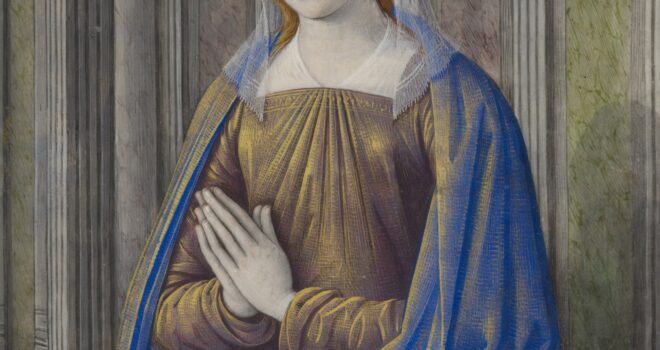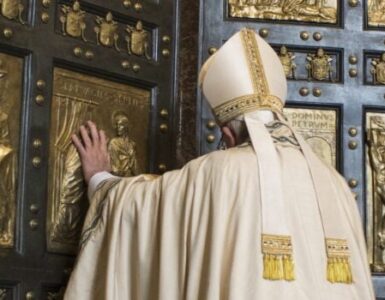The most ancient form of consecration in the Catholic Church is consecrated virginity, which is when a woman, through a special rite that traces back to apostolic times, promises to remain celibate for the rest of her life and offer herself entirely to God and His Church. The Catechism of the Catholic Church defines consecrated virgins as:
Virgins who, committed to the holy plan of following Christ more closely, are consecrated to God by the diocesan bishop according to the approved liturgical rite, are betrothed mystically to Christ, the Son of God, and are dedicated to the service of the Church.’ By this solemn rite (Consecratio virginum), the virgin is ‘constituted . . . a sacred person, a transcendent sign of the Church’s love for Christ, and an eschatological image of this heavenly Bride of Christ and of the life to come’ (923).
A woman who offers herself to God as a consecrated virgin is neither in the clerical state or the lay state, (CIC 588 §1) and is “mystically espoused to Christ and dedicated to the service of the Church, when the diocesan Bishop consecrates them according to the approved liturgical rite.” (CIC 604 §2) They live in the world in the same way as other women, and are not supported financially by their diocese, but they serve the local Catholic community under the authority of their bishop. Consecrated virgins typically do not wear a religious garment unless the bishop has permitted them to dress in such garb, and they are not addressed as “Sister.”
References to consecrated virginity appear in Sacred Scripture as well as in non-biblical texts. There is mention of the vocation in the New Testament found in Matthew 19:12, which reads “Some are incapable of marriage because they were born so; some, because they were made so by others; some, because they have renounced marriage for the sake of the kingdom of heaven. Whoever can accept this ought to accept it,” and also in 1 Corinthians 7:25-40, which states:
Now in regard to virgins, I have no commandment from the Lord, but I give my opinion as one who by the Lord’s mercy is trustworthy. So this is what I think best because of the present distress: that it is a good thing for a person to remain as he is. Are you bound to a wife? Do not seek a separation. Are you free of a wife? Then do not look for a wife. If you marry, however, you do not sin, nor does an unmarried woman sin if she marries; but such people will experience affliction in their earthly life, and I would like to spare you that. I tell you, brothers, the time is running out. From now on, let those having wives act as not having them, those weeping as not weeping, those rejoicing as not rejoicing, those buying as not owning, those using the world as not using it fully. For the world in its present form is passing away. I should like you to be free of anxieties. An unmarried man is anxious about the things of the Lord, how he may please the Lord. But a married man is anxious about the things of the world, how he may please his wife, and he is divided. An unmarried woman or a virgin is anxious about the things of the Lord, so that she may be holy in both body and spirit. A married woman, on the other hand, is anxious about the things of the world, how she may please her husband. I am telling you this for your own benefit, not to impose a restraint upon you, but for the sake of propriety and adherence to the Lord without distraction. If anyone thinks he is behaving improperly toward his virgin, and if a critical moment has come* and so it has to be, let him do as he wishes. He is committing no sin; let them get married. The one who stands firm in his resolve, however, who is not under compulsion but has power over his own will, and has made up his mind to keep his virgin, will be doing well. So then, the one who marries his virgin does well; the one who does not marry her will do better. A wife is bound to her husband as long as he lives. But if her husband dies, she is free to be married to whomever she wishes, provided that it be in the Lord. She is more blessed, though, in my opinion, if she remains as she is, and I think that I too have the Spirit of God.
Consecrated virginity has a rich history in the Catholic Church, as evidenced by the writings of Church Fathers such as St. Ignatius of Antioch, who referred to consecrated virgins as a distinct group in the Church in his letter to the Smyrnaeans around 110 A.D. Other Church Fathers, such as St. Cyprian and St. Ambrose, also addressed this special form of consecrated life in their treatises. Additionally, the Church’s oldest written liturgical records contain an early form of the Rite of Consecration to a Life of Virginity. We can also look to the saints for evidence of the existence of consecrated virgins in early Christianity when we look at the lives of women such as St. Cecilia, St. Agnes, St. Lucy, and St. Kateri Tekakwitha.
Consecrated virgins are called to live their lives especially following the example of the Blessed Virgin Mary, who we know according to the dogmatic teaching of the Church maintained a state of perpetual virginity throughout her life. According to Vatican News Pope Francis in his Message to Consecrated Virgins on the fiftieth anniversary of the promulgation of the revised Rite of Consecrated Virgins in May 2020 finishes his address with the following words, “As signs of the Church as Bride, may you always be women of joy, following the example of Mary of Nazareth, woman of the Magnificat, Mother of the living Gospel.”
The Rite of Consecration over time fell out of use due to the rise of monasticism in the early part of the sixth century A.D. and eventually during the Middle Ages became a vocation of the past. There were some religious orders that maintained the Rite however as a part of their solemn profession of vows and even continued until the twentieth century. I recall a Benedictine religious sister showing me a photo album of a traditional solemn profession in their community where the sisters wore a bridal dress and processed down the aisle of the Chapel with a candle in their hands, which was explained to me as being the Rite of Consecration to a Life of Virginity, which took place at the same time as the solemn profession of vows. Later after the Second Vatican Council and one of its fruits, the document Sacrosanctum Concillium, the ancient rite was revised and re-instated in the Catholic Church.
We see more and more women discerning consecrated virginity, especially women who had the desire in their hearts to become religious sisters, but left their orders due to often traumatic and abusive experiences in religious life. And there are many women making the decision to dedicate their lives to God and His Church as consecrated virgins, especially now during these turbulent and chaotic times of the twenty-first century.
The United States Association of Consecrated Virgins website reports that there are currently around 4,000 consecrated virgins in the Catholic Church worldwide. Of these, approximately 254 belong to a diocese in the United States, according to information presented at the January 2016 gathering of the Ordo Virginum in Rome to mark the close of the Year of Consecrated Life.
Recently, in New York we had two women become members of the Ordo Virginum. Several years ago there was a consecration to the sacred order in the Diocese of Brooklyn, and on this past Divine Mercy Sunday a woman promised a life of perpetual virginity as a bride of Christ in the Diocese of Ogdensburg.
The vocation of consecrated virginity is not often heard from the pulpit at Mass, but it should be included when we pray for more vocations to the priesthood, religious life, and marriage. It seems to be the often forgotten vocation even though it is the oldest vocation in the Catholic Church. Consecrated virginity existed before religious life, and is rooted in Sacred Scripture.
Let us pray for more vocations to this beautiful vocation, that more women will consider the calling to a life of perpetual virginity serving God and the Church. And for women who are interested in learning more about consecrated virginity and the new instruction on the Ordo Virginum they can read the Pope’s most recent document “ECCLESIAE SPONSAE IMAGO.”
Photo by British Library on Unsplash













